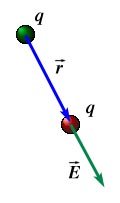Electric Field
Definition:
A test charge
is a charge which feels the force of other charges, but is too
small to exert any appreciable force on them.
This is, of course, just a mathematical abstraction. By
convention, a test charge is always taken as positive.
Definition:
The electric field,  (
( ),
at a point of observation,
),
at a point of observation,  ,
is the net Coulomb force acting on a test
charge q placed at that point
,
is the net Coulomb force acting on a test
charge q placed at that point  ,
per unit value of test charge, q:
,
per unit value of test charge, q:
 (
( )
=
)
=  (
( )
/ q
)
/ q
- The SI-unit of
the electric field therefore has to be N/C. Later in this chapter,
when we discuss potential (SI unit Volt(V)) we will see that this
is equivalent to the more commonly used V/m.
1 N/C = 1 V/m.
- The electric field is a vector, in the same direction as the
net Coulomb force vector at that point.
Electric field of a point
charge:
- The magnitude of the force felt by test charge q due to point
charge q1 at a distance r from it is the Coulomb
force:
|
Fc = k
|
q1 q
|
|

|
|
r2
|
- Thus the
magnitude
of the E-field of point charge q1 is:
|
E1(r) = Fc / q =
k
|
q1
|
|

|
|
r2
|

- Direction
of the field: If q1 is positive, it repels the
test charge q. Therefore the E-field due to a positive point
charge q1 points away from the charge, along the line
joining it with the point of observation (where the test charge q
is placed).
- Clearly, if q1 were negative, the field due to it
would point towards it, along the line joining it and the point of
observation.
©
MultiMedia Physics
2000
(
), at a point of observation,
, is the net Coulomb force acting on a test charge q placed at that point
, per unit value of test charge, q:
